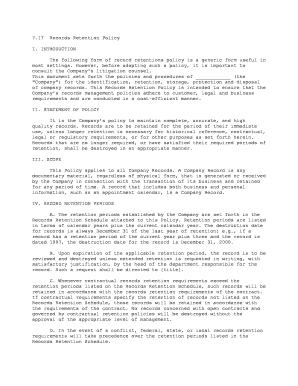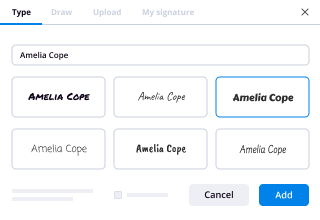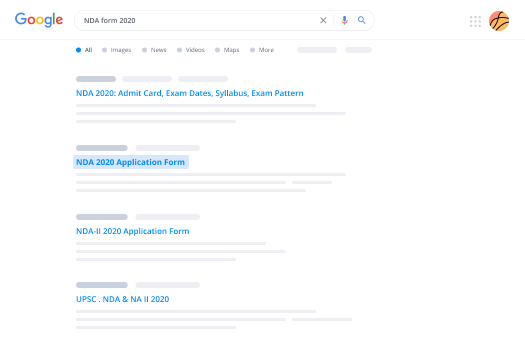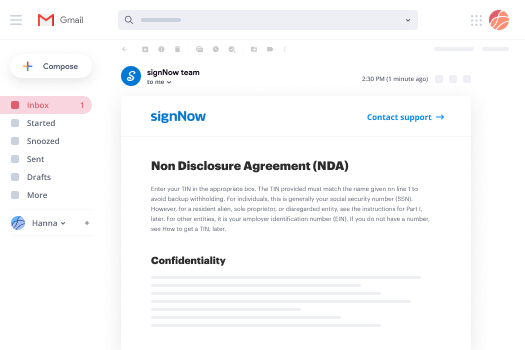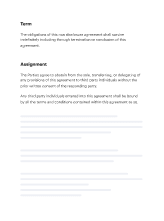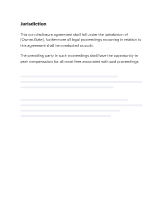7.17 Records Retention PolicyI. INTRODUCTION The following form of record retentions policy is a generic form useful in
most settings. However, before adopting such a policy, it is important to
consult the Company's litigation counsel.
This document sets forth the policies and procedures of ____________ (the
"Company") for the identification, retention, storage, protection and disposal
of company records. This Records Retention Policy is intended to ensure that the
Company's records management policies adhere to customer, legal and business
requirements and are conducted in a cost-efficient manner.
II. STATEMENT OF POLICY
It is the Company's policy to maintain complete, accurate, and high
quality records. Records are to be retained for the period of their immediate
use, unless longer retention is necessary for historical reference, contractual,
legal or regulatory requirements, or for other purposes as set forth herein.
Records that are no longer required, or have satisfied their required periods of
retention, shall be destroyed in an appropriate manner.
III. SCOPE
This Policy applies to all Company Records. A Company Record is any
documentary material, regardless of physical form, that is generated or received
by the Company in connection with the transaction of its business and retained
for any period of time. A record that includes both business and personal
information, such as an appointment calendar, is a Company Record.
IV. RECORD RETENTION PERIODS
A. The retention periods established by the Company are set forth in the
Records Retention Schedule attached to this Policy. Retention periods are listed
in terms of calendar years plus the current calendar year. The destruction date
for records is always December 31 of the last year of retention; e.g., if a
record has a retention period of the current year plus three and the record is
dated 1997, the destruction date for the record is December 31, 2000.
B. Upon expiration of the applicable retention period, the record is to be
reviewed and destroyed unless extended retention is requested in writing, with
satisfactory justification, by the head of the department responsible for the
record. Such a request shall be directed to [title].
C. Whenever contractual records retention requirements exceed the
retention periods listed on the Records Retention Schedule, such records will be
retained in accordance with the records retention requirements of the contract.
If contractual requirements specify the retention of records not listed on the
Records Retention Schedule, those records will be retained in accordance with
the requirements of the contract. No records concerned with open contracts and
governed by contractual retention policies will be destroyed without the
approval of the appropriate level of management.
D. In the event of a conflict, federal, state, or local records retention
requirements will take precedence over the retention periods listed in the
Records Retention Schedule.
E. Records relevant to a pending or reasonably anticipated legal action or
tax are not to be destroyed.
F. Any Company employee who believes the retention period governing any
type of records should be changed because of changes in legal, auditing or
management requirements, or believes a new item should be added to the Record
Retention Schedule, should submit a Request for Modification of Record Retention
Schedule to the [title] in the form established by the [title].
V. RECORDS SCREENING AND PURGING
A. Records are to be screened at least once every [time interval] to
determine if they are "Active Records" (i.e., subject to immediate use). The
screening process is to be planned and carried out within each Department.
B. Active records are to be stored in the immediate area of the
responsible custodian. Records determined to be inactive are to be reviewed for
possible off-site storage or for destruction pursuant to this Policy.
C. Factors to be considered in the screening process include:(1) Need for retention, including required retention periods set
forth in the Records Retention Schedule;
(2) Frequency of reference;
(3) Nature of reference; and
(4) Volume of files.
D. Duplicate and multiple materials are to be eliminated. Whenever
possible, the version of the record containing the most conclusive information
is the one to be retained. In general, the retained copy of a record should not
contain personal notations, other than the author's signature.
E. Records that have exceeded their required retention period are to be
reviewed and destroyed. Records are not to be transferred to off-site storage if
the retention period for such records expires within a year of the contemplated transfer.
F. Company supervisors are to ensure that the business files of
terminating or transferring employees are reviewed concurrent with the
employee's departure. Such files are to be reassigned to other employees or purged.
VI. RECORDS STORAGE
A. Records Center Storage(1) The Company will maintain a Records Center to store, control,
and protect inactive records. The Records Center will be in a safe, secure
location and protected from environmental and other potential harm.
(2) Records storage containers are to be labeled in sufficient
detail to facilitate prompt and accurate content identification by Records
Center personnel.
(3) Records are to be filed by year or specified periods to
facilitate their reference, review and/or destruction.
B. Vital Records Storage(1) The Company will establish a Vital Records Center separate from
the Records Center. The Vital Records Center shall, like the Records Center, be
in a safe, secure location protected from environmental and other harm.
(2) Each Department is to identify those records that are essential
to the continuity of the Company and designate them as Vital Records as soon as
practicable after the creation of the records. Such records include records which:
a. Are essential to the continuation of operations;
b. Are essential to [Company's] legal and financial status;
c. Are necessary for fulfillment of obligations to
stockholders, employees, customers and/or outside interests;
d. Contain secret processes, formulas, or innovations that are
not registered elsewhere; and,
e. Denote Company ownership of assets that would otherwise be
difficult or impossible to establish.
(3) Vital Records are to be duplicated and the duplicate records
stored in the Vital Records Center.
(4) Each Department is to maintain a current list of Vital Records
maintained by that Department and forward a copy of the list to the [title], who
shall maintain a master list of Vital Records for the Company.
C. Electronic Storage(1) The records management procedures and records retention periods
set forth in this Policy are applicable to electronic records. Records generated
and maintained in Company information systems or equipment (including mainframe,
mini, and micro computing/storage systems) are to be reviewed periodically by
applicable information owners and/or custodians to ensure that the requirements
set forth in this Policy are being met for electronic information systems.
(2) The use of magnetic tape, disc, or similar electronic media for
records storage purposes for periods that exceed one year is discouraged.
Special packaging, handling and environmentally controlled facilities are
required for storage periods exceeding one year. [Title] is to maintain
guidelines and advise personnel in accommodating long-term electronic media
storage requirements.
(3) Records stored in electronic media are to be grouped on single
medium (roll of tape, individual disc, etc.) in a fashion to facilitate review
and destruction at appropriate intervals.
D. Film Storage(1) The records management procedures and record retention periods
set forth in this Policy are applicable to information contained or stored on
film media, including microfilm, microfiche, or similar media.(2) The use of film for record storage and retention purposes is to
be selective to ensure cost effectiveness. [Title] shall develop standard
practices to be utilized when reducing information to film to ensure that
authenticity is not impaired.
(3) The use of film media for long-term records retention purposes
normally requires special packaging, handling, and environmentally controlled
facilities. [Title] is to maintain guidelines for such purposes and advise
personnel in their use.
(4) Records stored in film media are to be grouped on single media
(roll of film, single fiche, etc.) in a manner to facilitate review and
destruction at appropriate intervals.
VII. RESPONSIBILITIES
A. [Title of Responsible Officer]
[Title of Responsible Officer] has overall responsibility for developing,
implementing and maintaining the Company-wide records management process, in
accordance with the requirements set forth in this Policy, including:
(1) Maintaining records retention guidelines, as necessary, for the
implementation of this Policy;
(2) Updating the Records Retention Schedule attached to this Policy;
(3) Maintaining the index of Vital Records;
(4) Determining the applicability and acceptability of records for
retention and storage at the Records Center;
(5) Conducting orientation and training for Company personnel
involved in the records management process;
(6) Developing and maintaining the necessary records management
form(s);
(7) Preparing and maintaining inventories of records stored in the
Records Center;
(8) Ensuring that only authorized persons with a need-to-know gain
access to records stored in Records Centers; and
(9) Ensuring that stored records are retained, protected, retrieved,
returned to storage, reviewed and destroyed in accordance with the provisions of
this Policy.
B. Departments
Each Corporate department is responsible for assisting in the records
management process. Such responsibilities generally include:
(1) Supporting preparation and maintenance of local records
retention schedules;
(2) Identifying, packaging, documenting and transferring applicable
records to the Records Center;
(3) Retaining only those records for which they have custodial
responsibility;
(4) Requesting retrieval of records from the Records Center when
required by their respective functions;
(5) Returning records to the Records Center within the time period
established by the [title]; and
(6) Reviewing and authorizing destruction of records at the
retention expiration date.
C. Employees
All employees are responsible for ensuring that accurate and complete
records are identified, retained, stored, protected, and destroyed in accordance
with this Policy.
Useful suggestions for preparing your ‘The Following Form Of Record Retentions Policy Is A Generic Form Useful In’ online
Feeling overwhelmed by the burden of managing paperwork? Discover airSlate SignNow, the premier eSignature solution for both individuals and businesses. Bid farewell to the monotonous routine of printing and scanning documents. With airSlate SignNow, you can seamlessly execute and approve documents online. Take advantage of the extensive features within this intuitive and cost-effective platform to transform your document management experience. Whether you need to sign forms or gather electronic signatures, airSlate SignNow simplifies the process with just a few clicks.
Adhere to this comprehensive guide:
- Sign in to your account or initiate a free trial of our service.
- Hit +Create to upload a document from your device, cloud storage, or our template collection.
- Access your ‘The Following Form Of Record Retentions Policy Is A Generic Form Useful In’ in the editor.
- Select Me (Fill Out Now) to finalize the document on your end.
- Include and designate fillable fields for others (if necessary).
- Continue with the Send Invite settings to solicit eSignatures from additional parties.
- Save, print your copy, or transform it into a reusable template.
If you need to work together with your teammates on your The Following Form Of Record Retentions Policy Is A Generic Form Useful In or submit it for notarization, don’t be concerned—our platform provides all the tools you require to achieve these objectives. Sign up for airSlate SignNow today and elevate your document management to new heights!
place the guidelines for complying with a subpoena for medical records in the correct order.
Patient health records are retained based on
what data cannot be retrieved from the medpar?
which of the following should not be included in the steps of developing a record retention program?
which one of the following is not a data retrieval tool?
which patient factors constitute a closed medical record?
which of the following is not a component of a records management system?
A written request from an attorney for the records of a patient
